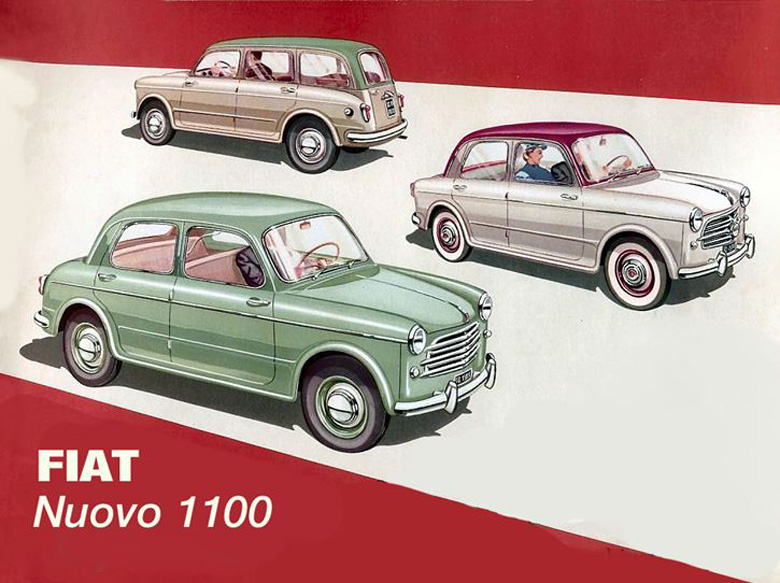
The three versions of their Nuovo 1100: The Berlina, the Familiare and the more sporting TV (Turismo Veloce), recognizable by the extra lamp mounted in center of the radiator grill. Photo courtesy Fiat.
Story by Gijsbert-Paul Berk and friends
In the continuing saga of the Fiat 1100, Gijsbert-Paul Berk presents the line of 1089 cc Fiats from the 1953 Nuovo 103 to the final variant, the 1969 1100 R.
Read Part 1
Read Part 2
Read Part 3
The postwar European economic boom created demand for workers in the industrialized triangle between the cities of Milan, Turin and Genoa. Around 9 million Italians moved from poor rural and mainly agricultural areas to find employment there. During those years, the Italian GPD grew with an average of 5.8% per year, very close to the German growth rate; the purchasing power of the population rose accordingly.
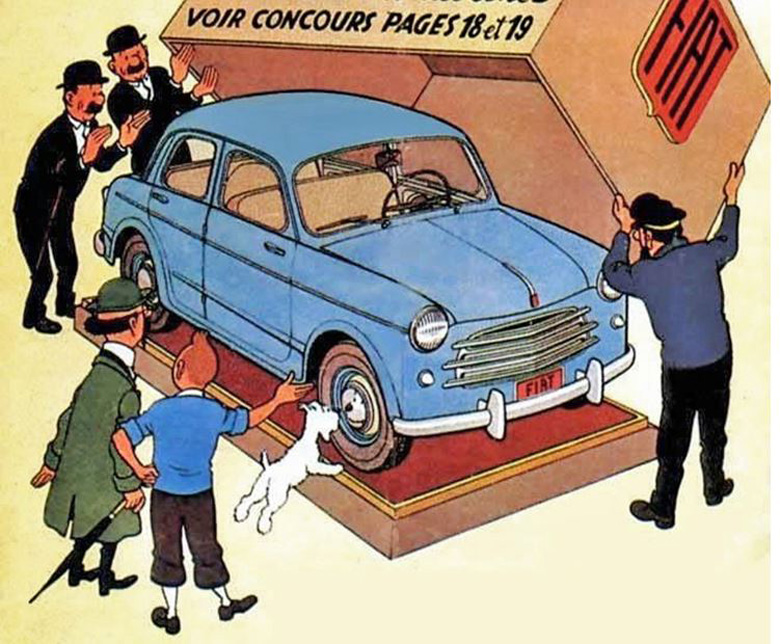
“Tintin and the secret of the Nuovo Fiat Millecento”. Most of us will remember Tintin, the fictional character created by the Belgian cartoonist Hergé (real name Georges Remi). Tintin and his dog Snowy figured in 24 comic albums, a lot of then with realistic drawn cars, as Hergé was a great admirer of automobiles. During the late 20th century “The Adventures of Tintin” was one of the most popular comic series. It was published in more than 70 languages and sold more than 200 million copies. Because they knew that Tintin was not only a favorite of many boys but very often of their fathers as well, in 1955 Fiat in collaboration with Hergé and his publisher organized a contest for the readers of Tintin as part of their international launch of the new 1100. Clever!
The development of the European Economic Community (EEC) meant a gradual switch from the postwar seller’s markets to buyer’s markets. To tempt buyers, most car European manufacturers (with the exception of Volkswagen) phased out their prewar models and introduced new and state-of-the-art designs to replace them.
To meet this demand, in 1948 Fiat updated the popular ’Topolino’ with the more modern looking 500 C. Two years later came the successor of the 1500. It was the completely new Fiat 1400 with a 1395 cc engine, a unit body construction and a full wide ‘pontoon’ shaped coachwork, clearly inspired by the styling of American cars such as Kaiser-Fraser and Ford.
1953: The“Nuovo” Fiat 1100/103
At the Geneva Motor show in April 1953, Fiat introduced its new 1100. Originally known by its internal project code name as the 1100/103, except for the engine it was a major redesign. Like the larger and up-market Fiat 1400 the new car had a unit body construction, and Fiat worked with the Budd Company in America on the new stampings. Giacosa termed the unit frame ‘bearing chassis’ and resulted in an important weight reduction at a time when cost of production was based upon weight. The Nuovo was 11% lighter than the 1100 E it replaced. Its smaller foot-print also helped. Compared with its predecessor the Nuovo offered slightly more interior space, but its wheelbase was reduced by 8 cm (3.5 inches) and its total length had shrunk with 33 cm (13 inches). Its full-wide rather boxlike body looked less elegant or if you wish, more functional than that of the four-door 1400.
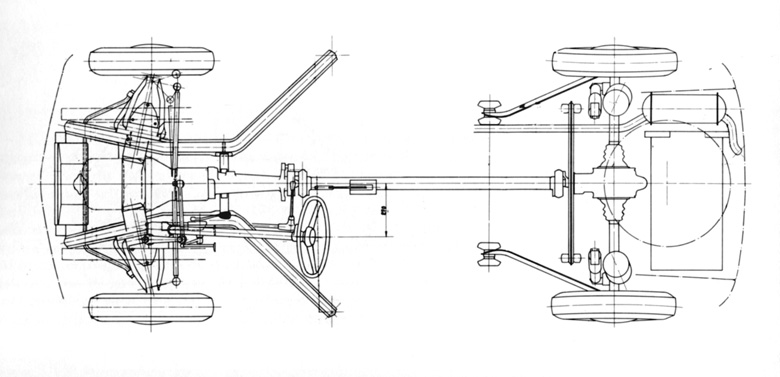
What could have been. Sketches of the 103 E3 chassis, with a front mounted V4 engine and swing axles at the rear. But the high roll center led to oversteer and the company opted for a suspension similar to the 1400.
Even if the Nuovo was completely redesigned, it conserved its conventional layout with a front-mounted engine and rear wheel drive through a live rear axle with leaf springs. The independent front suspension was adapted to allow the engine to be moved further forward, and again had coil springs and telescopic shock absorbers.

And what was. Although Giacosa had wanted to design a front-wheel drive car with a small V 4 engine, the Fiat management, for practical and economic reasons, decided to retain the 1089 cc four-cylinder in their Nuovo Millecento. But otherwise it was completely new, with a state-of-the-art unit-body construction. This cross section shows that the engine was mounted more forward, which implicated that the independent front suspension had to be redesigned as well. Also note the revised transmission- and rear-axle with allowed more interior space. Photo courtesy Fiat
Giacosa, by now Chief of Fiat’s technical department, was actively involved in the development of the 103. In his memoirs, he writes that his team designed a 944 cc four-cylinder engine in V configuration for the new car. They even made a few prototypes. But the Fiat management feared serious delays caused by testing and tooling and did not want to invest in its production. So, the small V4 was shelved* and the 1,089 cc (66 cu in) OHV four-in-line, with its origins dating back to 1937, was retained. And why not? Over the years, it had proven to be a hard-wearing, reliable and economical machine. The compression ratio was raised from 6.6 : 1 to of 6.7 : 1. Equipped with a single Solex or Weber downdraught carburetor the Nuova 1100 was good for 36 HP (26 kW) at 4,400 rpm.
*Note: Lancia, the other Turinese car manufacturer that same year replaced its Ardea with the Appia. This modern family saloon had a newly designed 1089 cc V4 with overhead valves, producing 38 HP at 4800 rpm. Lancia’s Chief engineer at that time was Antomio Fessia, Giacosa’s former boss at Fiat.
Turismo Veloce
Thanks to its safe and predictable road holding, precise steering and powerful brakes the Nuova 1100 was a pleasant car to drive. But a number of customers wanted more performance.

1953 Fiat 1100/103 TV. This model was faster and more luxurious finished and equipped. External differences: an extra lamp in the center of the radiator grill, a longer tail, the roof in a different color and white-wall tires. But under the bonnet there lived 50 horses instead of 36, a difference of nearly 40%. On this particular car one can see small wind deflector in the rear top half of the front door. This permitted one to drive fast with the windows slightly open, without too much air buffeting or draft. In those pre-a/c days that was quite an advantage. Photo courtesy Fiat
If you like this article, click here to subscribe to VeloceToday!
Therefore at the Salon de l‘Auto in Paris, in October 1953, Fiat presented a more sporting version of the 103, the 1100 TV (for Turismo Veloce, or Fast Touring). It was in fact the first time a major European manufacturer offered a factory tuned ‘high performance’ version of a popular family saloon. The Alfa Romeo Giulietta TI, Austin Cooper, Borgward TS, Ford Cortina GT and Renault Gordini followed later. The 1089 cc, engine of the TV, known as the type 103.006, had a compression ratio of 7.4 : 1, a twin choke Weber carburetor and developed 48 HP (35 kW) at 5400 rpm. The following year the compression ratio was raised to 7.6 : 1, which added another 2 HP. To reduce torsional vibrations caused by the increased engine power the one-piece propeller shaft was replaced by a two-piece one. With a top of 135 km/h (84 mph), the TV was nearly 16 % faster than the standard Nuova 1100. But it was also some 26% more expensive.

Apart from the extra lamp in the radiator grill, the TV differed from the standard Nuovo 1100 Berlina (left) by more pronounced rear lights and a larger boot (right). (Drawings courtesy Tutte Le Fiat)
Nevertheless, the TV became the favorite of many sporting drivers who needed a four-door family car but liked to participate in races and rallies. Such as the team Perdisa / Masetti Zanini who drove their 1100 TV to 3rd place in the 1300 class in the 1954 Mille Miglia.
1956: The 1100 103 E
In 1956 the 1100/103 received some attention. The new model was coined the 1100 103 E, and it got a much-needed boost in horsepower, from 36 hp to 40 hp in the standard saloon, and from 50 hp to 53 hp for the TV models.
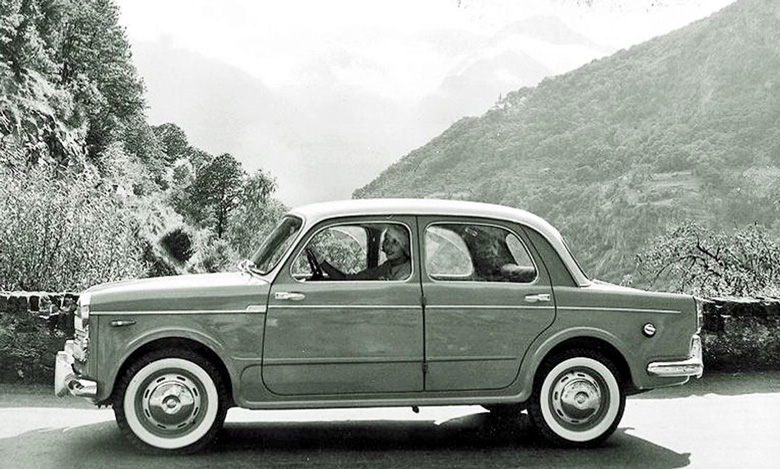
Black and white Fiat press kit photo of the 1955-6 1100/103 Berlina TV. Note longer rear end with larger boot and the two tone paint job. The standard saloon retained the earlier style bodies albeit with a grille-mounted center foglamp. Photo courtesy Fiat.
The single headlight (foglight) that helped to quickly identify the TV now became standard, but the performance model continued to be sold as the TV. The 1100 E would continue until the introduction of the 1100 D in October of 1957 after roughly 115,000 were built.
The TV Convertible
Along with the 1100 E series came a significant step for Fiat, the introduction of a small sports car, the 1100 E TV Trasformabile, or convertible in 1955. Although designed with the new U.S. market in mind, the 50 hp engine was not powerful enough to propel the 2,280 lbs. car in a sporting fashion. The body was developed by Fabio Luigi Rapi for Fiats own coachwork department that also took care of its production. Only 571 were constructed before morphing into the 1200 Convertible in 1957, then into the remarkable and definitively Italian 1200 Pinin Farina Spider. The concept eventually evolved to become the Fiat-OSCA 1600 with a much better power to weight ratio.
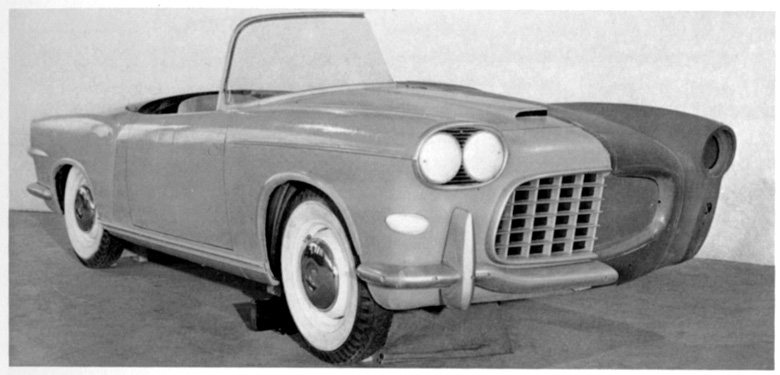
When the TV Convertible was being developed, a mock-up was made to compare the use of dual headlights.
Wisely the final design kept the standard two-headlight configuration.

At the 1955 Geneva Motor show Fiat surprised the public with an attractive two seat roadster, officially called the Fiat 1100 TV Trasformabile. The panoramic windscreen and chrome trim on the rear fender indicated that the car had been designed with an eye on the US market. Shown here is a 1957 1200 model.
1957: The 1100 D
In October of 1957, the 1100 D was introduced, and the TV was upgraded to the 1221 cc engine, and the name changed to “1200 Granluce.” The 1100 D, which retained the 1098 cc engine, took on a more modern look and the braking system was improved.
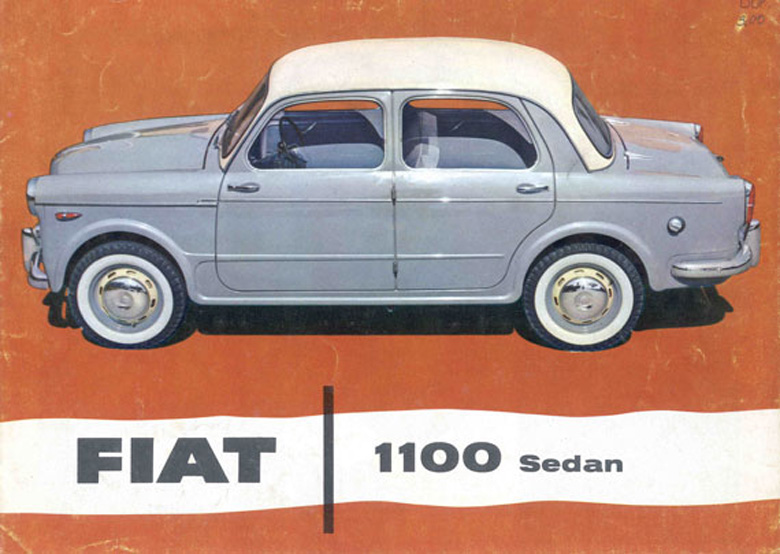
For the U.S., the Fiat 1100 D was often just called the 1100 and the De Luxe. U.S. brochure circa 1961.
Thanks to the Roosevelt Fiat distributor, The 1100 D was imported to the U.S. in relatively large numbers. The 1100 D series lasted until 1960 when over 150,000 were produced.
1959: The 1100 103 H
The 1089 cc engine, which dated from 1937, just wouldn’t go away. The Deluxe H version came online in 1959 with 50 hp at 5200 rpm. It sported a new grille, rubber inserts in the bumpers and two-tone paint job. This model was offered to fit between the 1100 D and the new 1200 Granluce models.
Export versions
The Nuova Fiat 1100 would become one of the first ‘world cars’, being produced or assembled in no less than seven countries on five continents: Asia (Mumbai, India), Australia (Melbourne), Europe (Turin, Italy and Neckarsulm, Germany), North Africa (Casablanca, Morocco and Teheran, Iran) and South America (Caseros, Argentina).
NSU and Fiat had a license agreement in place since 1934, which permitted the NSU factory in Neckarsulm, Germany to build Fiat designed cars. After WWII, this agreement was renewed and the cars were marketed as NSU-FIAT and later under the label Neckar.

An 1100 by any other name is still an 1100. This is a Neckar, a Fiat 1100 built in Neckarsulm, Germany.
In the late fifties the Vereinigten Fahrzeugwerke AG Neckarsulm produced the Fiat 500 (Neckar Weinsberg), 600 (Neckar Jagst) and 1100 (Neckar Europa). All of them slightly modified, often more luxurious finished and sometimes sportier than their counterparts made in Turin. But they were also more expensive as a result of the strong Deutschmark and high labor costs. In total 159.731 units of the 1100 Neckar Europe were produced.
When NSU resumed manufacturing motorcycles and also developed its own small car, the NSU Prinz, targeting the same market segments as the Fiats, the Italo-German marriage ended in a divorce.
1966: The 1100 R
By 1962 the range of 1100s with a 1089 cc engine had just about disappeared, replaced by the healthier 1221 cc engine and the cars branded as “1200s.” But even then, the 1089 cc engine was not quite dead yet.
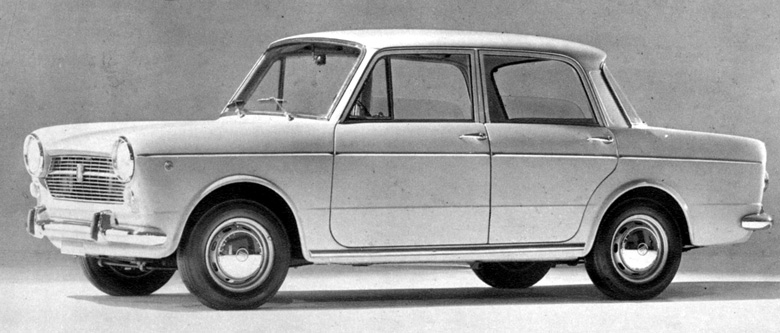
The 1100 R. Some 32 years after the introduction of the 1089 cc Millecento, the 1100 was finally put to rest. At least, in Italy….
In 1966, it was decided revised the old 1100 body and equip it with the 1089 cc powerplant. This model was originally designed to be built in Pakistan, but was instead made in Italy. It had a floor shift, the same output as the 1221 cc engine, and the body was looking a lot like the new 124. It was billed as the 1100 R (for revised) and a whopping 340,000 were built before the end of production in 1969.
But wait, there’s more. In 1992 the Fiat 1100 was reincarnated, of course in India. The story of the Padmini coming up in VeloceToday.

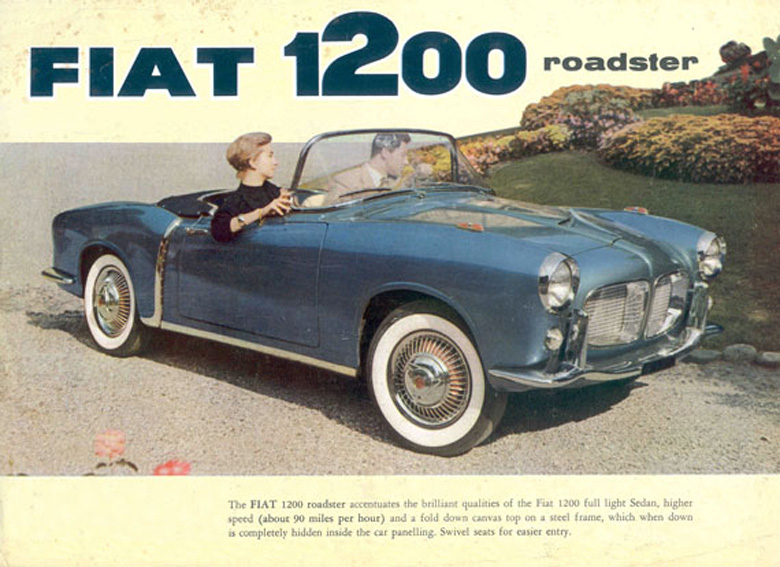
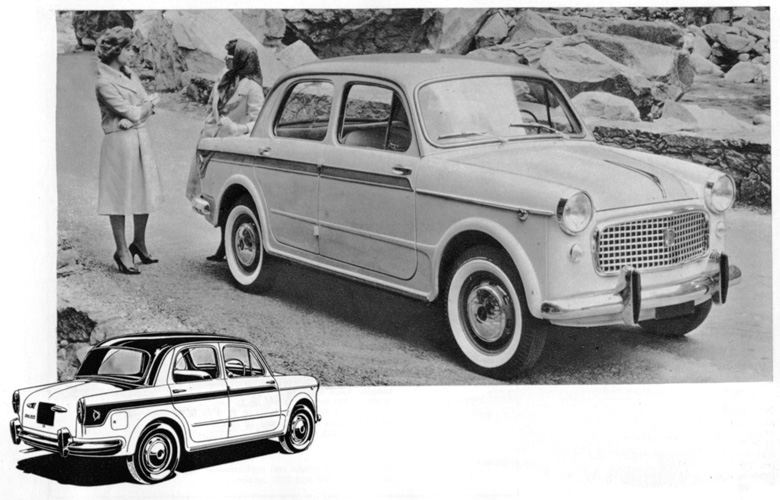
While it’s great to see more information on the 103 series published, and made available to the public (especially as one of my clients has a 1200 TV Trasformabile coming up for auction in Monterey in a couple of weeks), it’s disappointing that so many of the “little facts” of this article are incorrect…
The red 1100 TV trasformabile pictured is really a USA version 1957 1200, the 1200 Roadster factory brochure with the extremely rare “aquaverde” color represented as a US brochure, is actually the original German brochure (with a European specification car pictured) with the writing in English, and the 1960 Sedan drawings from Tutte Le Fiat, the car on the right is actually the 1966 1100 R!
And that’s just the pictures…
But as I said, it’s great to see more recognition of these great Italian cars that have been overlooked for so long!
Chris,
It’s great to hear from you and we still treasure your work on Fiat, “Obert’s Fiat Guide”, written by Genevieve and published by VelocePress, which at the time, (2005) was our partner Stephen Glenn. On the errors in our article, we’ll make the above corrections. If you see any other errors in the text do let us know. Of course, the history of the 1100 is complex and not easily presented in a short story such as ours, so any help you can provide to make the article more accurate is greatly appreciated.
Pete
A big addendum – without the 1100, would we have had Formula Junior? Remember, the original FJ rules almost spelled out a FIAT 1100 drive line.
Denny, glad you mentioned it. Yes, that is coming up as the last part of the series on the Fiat 1100.
Pete
Seeing the 1100 sedan takes me back to Modena in Fall of 1957, and riding with Ferrari
race manager Tavoni down to the factory. Up front was driver Phil Hill who had engaged Tavoni in heated dialogue of his wanting to drive Grand Prix the next year.
Team manager was not a very good driver and with avoiding errant bicyclist on the road
I had to surpress laughing at the whole scene.! Hill was telling him how he had offers
from Teams like BRM, which had an element of truth as Raymond May was in town and looking to recruit better drivers.
Scuderia Ferrari had several of them in dull Gray color. and I did photograph one
towing a Ferrari 801 around the paddock at Nurburgring to get it to fire up.
That early morning shot reproduced in Ferrari Album of Jonathan Thompson
Thanks for the Memories
Jim Sitz
Interesting article about a great little car, but one certainly never finished 3rd in the 1954 Mille Miglia – I suspect some confusion with another event.
Thanks Nick and where have you been? We missed you. I fixed the error.
Pete
The mentioning of the 3rd in the -1300 class win of the 1954 Mille Miglia (and 57th overall) is correct.
see also http://www.racingsportscars.com/results/Mille_Miglia-1954-05-02.html
Amazing feat for such a simple mass production car!
Joost,
Glad we got it right. It previously read that the team placed 3rd overall, to which Lancaster rightly objected….
Pete
With all respect; I beg to differ with Mr. Obert. The car on right, in the Tutte Le Fiat drawing, is not the “R” model. That can be detected when one compares it with the last photo in the article(which is the actual 1100R).
Thanks…to avoid confusion, I deleted that particular set of images.
But don’t despair, next week’s installment of the 1100 saga will giver everyone something to comment on…
Pete
Pabst Motors in Milwaukee took on the Fiat line in late 1959 with hopes of at least giving VW a run for it’s money. Didn’t happen! The 1100 and 1200 sedans were just too blah and the 600 too small. The Fiat 1100 powered Stangullini FJ was something else, ran forever with little maintenance, very forgiving in corners and fun to drive. Mine was the same one that Augie Pabst touched wheels with Susie Dietrich’s car at Road America and became airborne leaving evidence of a tire tread on the underside. So while the Fiascos, er Fiat passenger cars left much to be desired back then the cars running running gear was terrific.